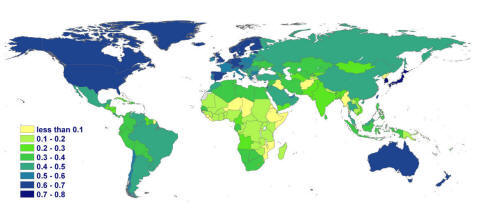Measuring The Information Society 2007: ICT Opportunity Index and World Telecommunication/ICT Indicators
Citation:
Work data:
ISBN: 28974Alternate URL: http://www.itu.int/ITU-D/ict/publications/ict-oi/2007/index.html
http://www.itu.int/ITU-D/ict/publications/ict-oi/2007/index.html
Type of work: Report
Categories:
Digital Divide | e-Readiness | ICT Infrastructure | ICT4D | Information SocietyAbstract:
The publication contains both the 2007 ICT Opportunity Index and the World Telecommunication/ICT Indicators (WTI). The index highlights that while countries have made significant progress since the turn of the century, digital opportunities remain unequally distributed. The ITU’s authoritative World Telecommunication/ICT Indicators (WTI) tables present statistics for year-end 2005. These statistics monitor the main indicators of telephone network growth, mobile communications, internet subscribers and internet users, tariffs, revenues and investment for around 200 economies worldwide.
It’s a pity that the graphical representation of the Digital Opportunity Map has changed colors, as it makes it more difficult to compare among years. Nevertheless, here come both maps for 2006 and 2005 (remember that the report shows the DOI for the preceding year):
Major improvements — DOI increases above 20%, World Rank increases above 5 places (most of them are two digits increases) — are those of Antigua & Barbuda, Bangladesh, Barbados, Cambodia, Fiji, Guatemala, Lao P.D.R., Nicaragua, Palestine, Rwanda, St. Kitts & Nevis and Tanzania, reinforcing the trend of some Central America, Africa and Asia countries taking off and showing the path to other countries of the region with poor e-readiness results.
Getting worse — DOI decreases and loss of World Rank places —: Central African Republic, D.R. Congo, Madagascar, Turkmenistan and Zimbabwe, which as happened with the climbers, I think, sadly, does not surprise anyone.
Some other main conclusions are the huge strength of mobile telephony adoption in developing countries — in particular — and in the whole World — in general —, that makes coverage be almost universal and, thus, make the digital divide […] shrinking
. We’ve talked about this statement several times here, and luckily, this time the report warns about the danger that those infrastructures make broadband adoption more difficult than fixed lines, hence the availability and affordability of broadband remain a cause for concern
.
Actually, even if decreasing, inequality in digital development in the World (measured, for instance, through Internet usage) is still a major problem far to be solved and, if worst scenarios about broadband penetration come true, eager to get worse.




